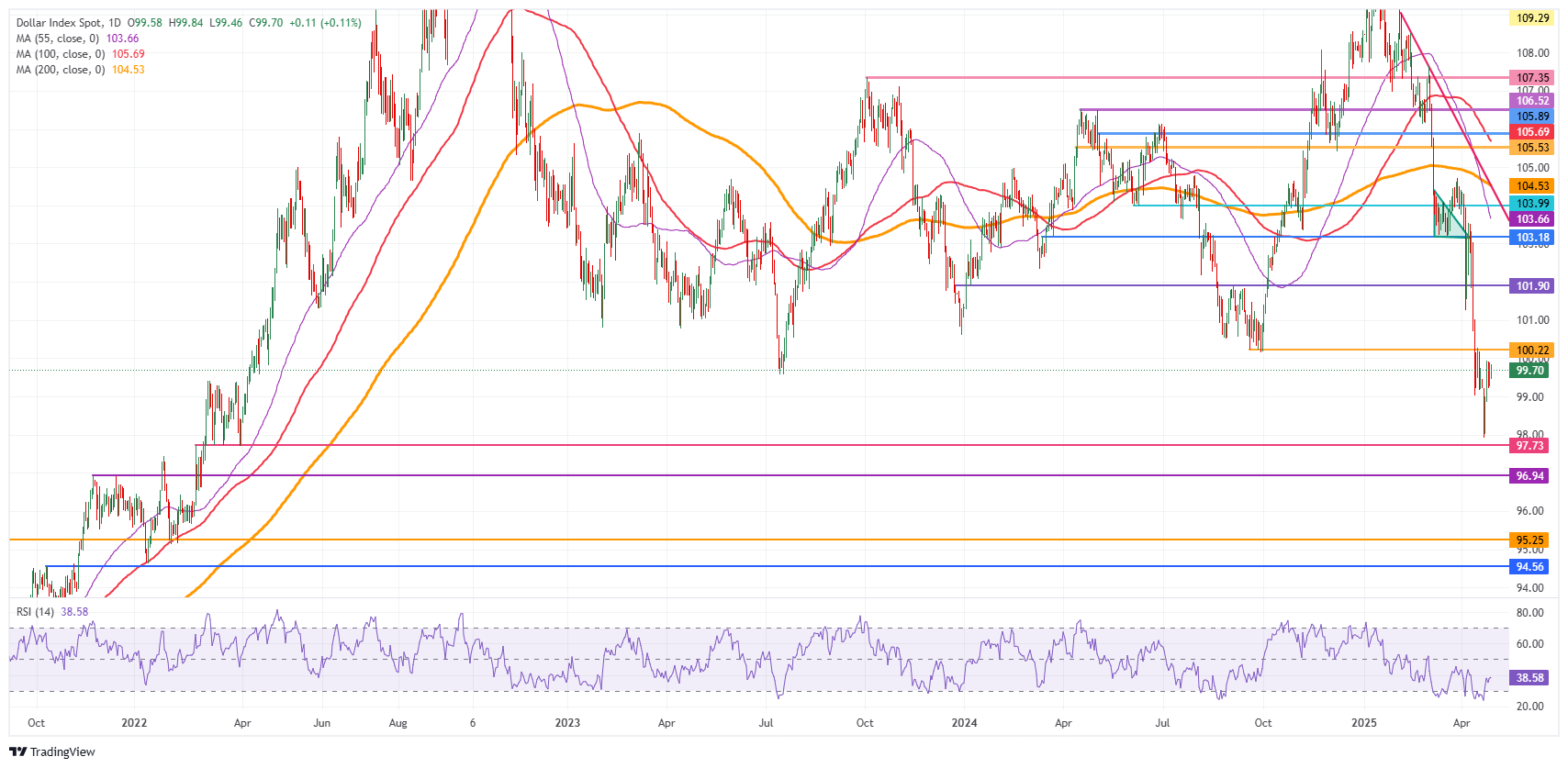US Dollar steadies near pivotal breakout level ahead of data-packed week
- The US Dollar trades broadly flat as traders brace for a very packed week of geopolitical events and US data.
- The Trump administration insists that it is in talks with China on trade, but China keeps dismissing these claims.
- The US Dollar Index remains capped below the 100.00 round level.
The US Dollar Index (DXY), which tracks the performance of the US Dollar (USD) against six major currencies, trades broadly flat on Monday just below the 100.00-marker. Over the weekend, United States (US) Treasury Secretary Scott Bessent said trade deal negotiations with several Asian countries are underway, while US Agriculture Secretary Brooke Rollins added that the Trump administration is having “daily conversations” with China over tariffs.
However, China said on Monday that it is not engaged in trade negotiations with the US. The country reiterated that there are no winners in a tariff trade war and that the US should talk on a basis of mutual respect, Bloomberg reported.
On the economic calendar front, a very packed week is ahead. The data will likely help traders assess if the Federal Reserve (Fed) will deliver an interest-rate cut in its upcoming policy meeting on May 7. The main attention this week will be on Wednesday, with the first reading of the US Gross Domestic Product (GDP) for the first quarter. Next, on Friday, the US Employment report for April – which includes the all-important Nonfarm Payrolls number – is the main event to close off the week.
Daily digest market movers: To talk or not to talk
- The Trump administration over the weekend has commented repeatedly that it is in talks with China on a trade deal. China said on Monday it is certainly not in any trade talks, Bloomberg reports.
- The US economic calendar is light on Monday. At 14:30 GMT, the Dallas Fed Manufacturing Business Index for April is due. No forecast available with the previous reading at -16.3.
- There are no scheduled Federal Reserve speakers this week as the blackout period has started ahead of the Federal Open Market Committee (FOMC) meeting and rate decision on May 7.
- Equities trade mixed this Monday. The only outlier was the Japanese Topix, which closed nearly 1% up. European equities are broadly positive, while US futures look rather sluggish.
- The CME FedWatch tool shows the chance of an interest rate cut by the Federal Reserve in May’s meeting stands at 8.9% against a 91.1% probability of no change. The June meeting has around a 61.9% chance of a rate cut.
- The US 10-year yields trade around 4.26%, looking for direction at the calm start the week.
US Dollar Index Technical Analysis: No clarity, no movement
The US Dollar Index (DXY) is not going anywhere as traders are keeping their powder dry for the US data later this week and amid constant woes over whether the US and China are in talks about trade.
On the upside, the DXY’s first resistance comes in at 100.22, which supported the DXY back in September 2024, with a break back above the 100.00 round level as a bullish signal. A firm recovery would be a return to 101.90, which acted as pivotal level throughout December 2023 and again as base for the inverted head-and-shoulders formation during the summer of 2024.
On the other hand, the 97.73 support could quickly be tested on any substantial bearish headline. Further below, a relatively thin technical support comes in at 96.94 before looking at the lower levels of this new price range. These would be at 95.25 and 94.56, meaning fresh lows not seen since 2022.

US Dollar Index: Daily Chart
US-China Trade War FAQs
Generally speaking, a trade war is an economic conflict between two or more countries due to extreme protectionism on one end. It implies the creation of trade barriers, such as tariffs, which result in counter-barriers, escalating import costs, and hence the cost of living.
An economic conflict between the United States (US) and China began early in 2018, when President Donald Trump set trade barriers on China, claiming unfair commercial practices and intellectual property theft from the Asian giant. China took retaliatory action, imposing tariffs on multiple US goods, such as automobiles and soybeans. Tensions escalated until the two countries signed the US-China Phase One trade deal in January 2020. The agreement required structural reforms and other changes to China’s economic and trade regime and pretended to restore stability and trust between the two nations. However, the Coronavirus pandemic took the focus out of the conflict. Yet, it is worth mentioning that President Joe Biden, who took office after Trump, kept tariffs in place and even added some additional levies.
The return of Donald Trump to the White House as the 47th US President has sparked a fresh wave of tensions between the two countries. During the 2024 election campaign, Trump pledged to impose 60% tariffs on China once he returned to office, which he did on January 20, 2025. With Trump back, the US-China trade war is meant to resume where it was left, with tit-for-tat policies affecting the global economic landscape amid disruptions in global supply chains, resulting in a reduction in spending, particularly investment, and directly feeding into the Consumer Price Index inflation.


